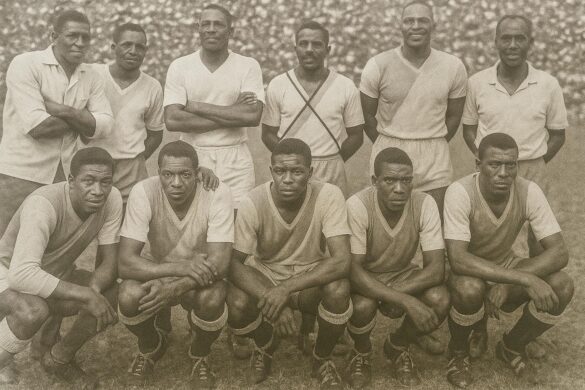Youth in Owando and the Dusty Pitches of Poto-Poto
Born on December 28, 1949, in Fort-Rousset, today known as Owando, Gilbert “Milou” Itsa grew up in a civil servant household that valued discipline as much as ambition. The dusty pitches of northern Congo first honed the left foot that would soon captivate fans across the country.
He moved to Brazzaville for his secondary education, enrolling as a boarder at the Lycée Savorgnan-de-Brazza. Between classes, he frequented the rudimentary ground of the Stade de la Grande École, where the neighborhood team Elite refined his instinctive dribbling.
Future ministers Pierre Oba and Henri Ossébi shared this makeshift locker room, proof of football’s unlikely power to unite a generation. Itsa’s reputation crossed the Congo River, and soon the Yougos pitch in the Bacongo neighborhood called to him on weekend afternoons.
Rise with Squadra Azzurra and CARA Brazzaville
The teenage winger joined Squadra Azzurra, the legendary Poto-Poto club that had once produced the great Dzabana “Jadot”. Match days began with climbing a dormitory wall and ended with spectators chanting his name after another devastating run down the touchline.
In 1965, Club Athlétique Renaissance Aiglon – better known as CARA – signed him, pairing the young player with famous names like Emmanuel Mayanda, Gilbert “Bolida” Makouana, and Bosco “Mustang” Moukassa. The locker room, rich in nicknames and charisma, became a school of excellence for his art.
Observers remember the ease with which he would slow the pace, roll the ball under his sole, then explode past defenders. A cultured left foot allowed direct corner kicks to nestle in the far post, a rarity that made stadiums roar.
International Feats and Unforgettable Matches
National team scouts took note, granting Itsa his senior debut in 1969. That same year, Congo faced the touring Brazilian side FC Santos, led by Pelé. Although the visitors won, local newspapers praised the fearless teenager who exchanged feints with the global icon.
Six seasons in red, green, and gold followed, culminating in a 1975 trip to Kinshasa where CARA tormented CS Imana. The Brazzaville press still replays his curling shot that stunned the packed 20 Mai Stadium and silenced the partisan chants.
Studies in France and Brief Stints in Europe
In 1971, the winger took a break, boarding an Air Afrique flight to Paris. Law books replaced training cones as he pursued a license and then a master’s degree in legal sciences at Paris VIII University.
Yet, football called from beyond the lecture hall windows. He played for Maisons-Alfort from 1971 to 1973, moved to Juvisy until 1977, and closed the European chapter with Marc-en-Barœul the following season. Summer holidays invariably meant a return to Brazzaville and CARA.
Diplomas in hand, Itsa joined the Congolese police in 1978, who automatically assigned him to Inter Club, the force’s team. After only a few appearances, he retired.
